

Compact Muon Solenoid
LHC, CERN
| CMS-HIN-21-008 ; CERN-EP-2023-052 | ||
| Measurements of the azimuthal anisotropy of prompt and nonprompt charmonia in PbPb collisions at $ \sqrt{\smash[b]{s_{_{\mathrm{NN}}}}} = $ 5.02 TeV | ||
| CMS Collaboration | ||
| 25 May 2023 | ||
| JHEP 10 (2023) 115 | ||
| Abstract: The second-order ($ v_{2} $) and third-order ($ v_{3} $) Fourier coefficients describing the azimuthal anisotropy of prompt and nonprompt (from b-hadron decays) J/$\psi$, as well as prompt $ \psi $(2S) mesons are measured in lead-lead collisions at a center-of-mass energy per nucleon pair of $ \sqrt{\smash[b]{s_{_{\mathrm{NN}}}}} = $ 5.02 TeV. The analysis uses a data set corresponding to an integrated luminosity of 1.61 nb$^{-1}$ recorded with the CMS detector. The J/$\psi$ and $ \psi $(2S) mesons are reconstructed using their dimuon decay channel. The $ v_{2} $ and $ v_{3} $ coefficients are extracted using the scalar product method and studied as functions of meson transverse momentum and collision centrality. The measured $ v_{2} $ values for prompt J/$\psi$ mesons are found to be larger than those for nonprompt J/$\psi$ mesons. The prompt J/$\psi$ $v_{2} $ values at high $ p_{\mathrm{T}} $ are found to be underpredicted by a model incorporating only parton energy loss effects in a quark-gluon plasma medium. Prompt and nonprompt J/$\psi$ meson $ v_{3} $ and prompt $ \psi $(2S) $ v_{2} $ and $ v_{3} $ values are also reported for the first time, providing new information about heavy quark interactions in the hot and dense medium created in heavy ion collisions. | ||
| Links: e-print arXiv:2305.16928 [hep-ex] (PDF) ; CDS record ; inSPIRE record ; HepData record ; CADI line (restricted) ; | ||
| Figures | |

png pdf |
Figure 1:
Invariant mass (left) and $ \ell_{\mathrm{J}/\psi} $ (right) distributions for the bin of 3.0 $ < p_{\mathrm{T}} < $ 4.5 GeV/$c$ and 0.0 $ < v_{2} < $ 0.3 in centrality 10-60%. The solid lines represent the total fit, while the dashed and dash-dotted lines represent the prompt and nonprompt components, respectively. The background contributions are shown by the filled blue histograms. |

png pdf |
Figure 1-a:
Invariant mass distribution for the bin of 3.0 $ < p_{\mathrm{T}} < $ 4.5 GeV/$c$ and 0.0 $ < v_{2} < $ 0.3 in centrality 10-60%. The solid line represents the total fit, while the dashed and dash-dotted lines represent the prompt and nonprompt components, respectively. The background contributions are shown by the filled blue histogram. |
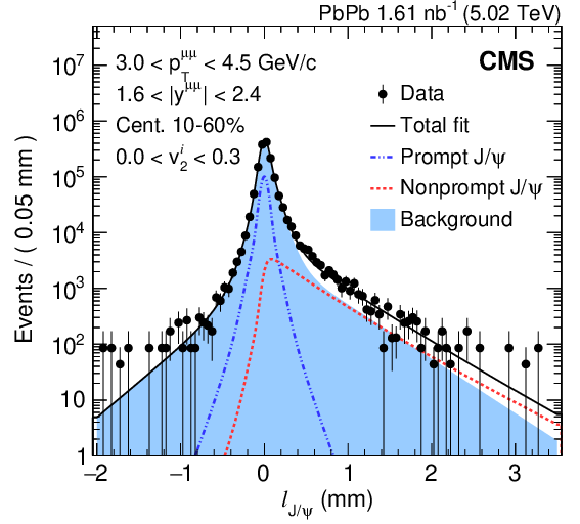
png pdf |
Figure 1-b:
$ \ell_{\mathrm{J}/\psi} $ distribution for the bin of 3.0 $ < p_{\mathrm{T}} < $ 4.5 GeV/$c$ and 0.0 $ < v_{2} < $ 0.3 in centrality 10-60%. The solid line represents the total fit, while the dashed and dash-dotted lines represent the prompt and nonprompt components, respectively. The background contributions are shown by the filled blue histogram. |
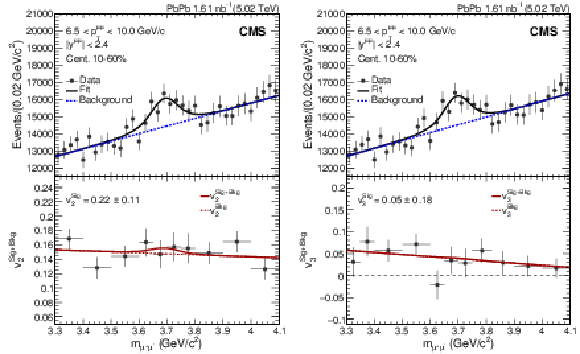
png pdf |
Figure 2:
Simultaneous fits of the dimuon invariant mass spectrum and the $ v_{2}^{\text{Sig+Bkg}} $ (left) and $ v_{3}^{\text{Sig+Bkg}} $ (right) distributions for $ \psi $(2S) mesons, as defined by Eq. (5), for 6.5 $ < p_{\mathrm{T}} < $ 10 GeV/$c$ and centrality 10-60%. In the upper panel, the solid black (signal + background) and dashed blue (background only) lines show the result of the mass fit. In the lower panel, the vertical lines of the $ v^{\text{Sig}}_{n} $ points represent the statistical uncertainty. The solid ($ v_{n} $ signal + background) and the dashed ($ v_{n} $ background) lines indicate the corresponding fit to the $ v_{n} $ distributions. |
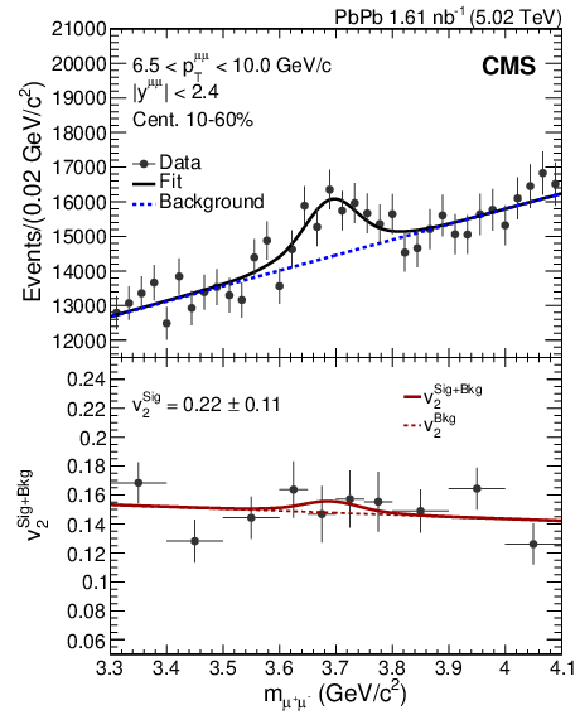
png pdf |
Figure 2-a:
Simultaneous fits of the dimuon invariant mass spectrum and the $ v_{2}^{\text{Sig+Bkg}} $ distribution for $ \psi $(2S) mesons, as defined by Eq. (5), for 6.5 $ < p_{\mathrm{T}} < $ 10 GeV/$c$ and centrality 10-60%. In the upper panel, the solid black (signal + background) and dashed blue (background only) lines show the result of the mass fit. In the lower panel, the vertical lines of the $ v^{\text{Sig}}_{2} $ points represent the statistical uncertainty. The solid ($ v_{2} $ signal + background) and the dashed ($ v_{2} $ background) lines indicate the corresponding fit to the $ v_{2} $ distribution. |
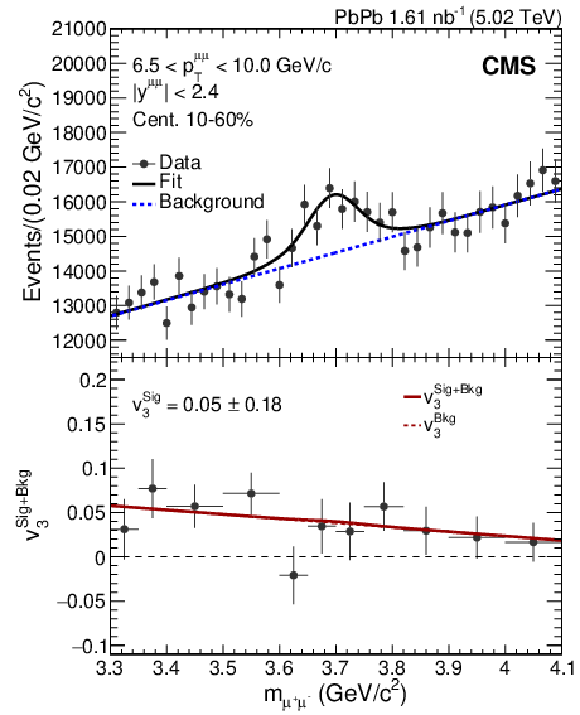
png pdf |
Figure 2-b:
Simultaneous fits of the dimuon invariant mass spectrum and the $ v_{2}^{\text{Sig+Bkg}} $ distribution for $ \psi $(2S) mesons, as defined by Eq. (5), for 6.5 $ < p_{\mathrm{T}} < $ 10 GeV/$c$ and centrality 10-60%. In the upper panel, the solid black (signal + background) and dashed blue (background only) lines show the result of the mass fit. In the lower panel, the vertical lines of the $ v^{\text{Sig}}_{3} $ points represent the statistical uncertainty. The solid ($ v_{3} $ signal + background) and the dashed ($ v_{3} $ background) lines indicate the corresponding fit to the $ v_{3} $ distribution. |

png pdf |
Figure 3:
The $ v_{2} $ (upper) and $ v_{3} $ (lower) values, as functions of $ p_{\mathrm{T}} $ (left) and $ \langle\mathrm{N}_\text{part}\rangle $ (right) for prompt and nonprompt J/$\psi$ mesons. The results for 3 $ < p_{\mathrm{T}} < $ 6.5 and 6.5 $ < p_{\mathrm{T}} < $ 50 GeV/$c$ are studied in the rapidity range of 1.6 $ < |y| < $ 2.4 and $ |y| < $ 2.4, respectively (left). The kinematic range for the right panel is 6.5 $ < p_{\mathrm{T}} < $ 50 GeV/$c$ and $ |y| < $ 2.4. The data points are positioned in the middle of each $ p_{\mathrm{T}} $ bin. The vertical bars denote the statistical uncertainties and the rectangular bands show the systematic uncertainties. |

png pdf |
Figure 4:
The $ v_{2} $ values of prompt J/$\psi$ mesons (blue circles) as a function of $ p_{\mathrm{T}} $ in the 10-60% centrality range compared with a model calculation in Ref. [31] (green dashed line). The results for 3 $ < p_{\mathrm{T}} < $ 6.5 and 6.5 $ < p_{\mathrm{T}} < $ 50 GeV/$c$ are studied in the rapidity range of 1.6 $ < |y| < $ 2.4 and $ |y| < $ 2.4, respectively. The vertical bars denote the statistical uncertainties and the rectangular bands show the systematic uncertainties. |
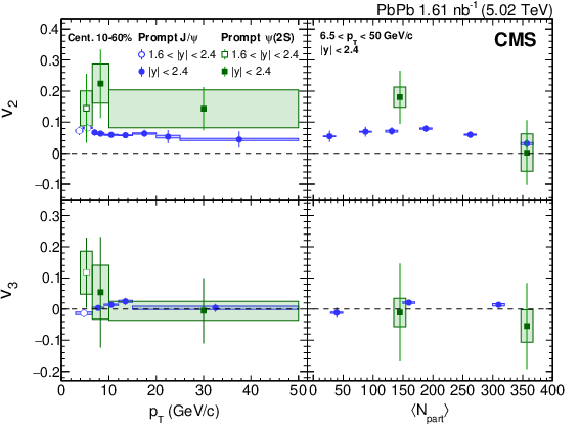
png pdf |
Figure 5:
The $ v_{2} $ (upper) and $ v_{3} $ (lower) values, as functions of $ p_{\mathrm{T}} $ (left) and $ \langle\mathrm{N}_\text{part}\rangle $ (right) for prompt J/$\psi$ (blue circles) and prompt $ \psi $(2S) (green squares) mesons. The results for $ p_{\mathrm{T}} < $ 6.5 and $ p_{\mathrm{T}} > $ 6.5 GeV/$c$ are studied in the rapidity range of 1.6 $ < |y| < $ 2.4 and $ |y| < $ 2.4, respectively (left). The kinematic range for the right panel is 6.5 $ < p_{\mathrm{T}} < $ 50 GeV/$c$ and $ |y| < $ 2.4. The data points are positioned in the middle of each $ p_{\mathrm{T}} $ bin. The vertical bars denote the statistical uncertainties and the rectangular bands show the systematic uncertainties. |
| Tables | |

png pdf |
Table 1:
Summary of the absolute total systematic uncertainty and its dominant contributions, in units of 10$^{-3} $. |

png pdf |
Table 2:
A Summary of the kinematic regions for J/$\psi$ and $ \psi $(2S) in the centrality interval 10-60%. |

png pdf |
Table 3:
The centrality classes and $ \langle\mathrm{N}_\text{part}\rangle $ values for PbPb collisions at $ \sqrt{\smash[b]{s_{_{\mathrm{NN}}}}} = $ 5.02 TeV used in this study. |
| Summary |
| The second-order ($ v_{2} $) and third-order ($ v_{3} $) Fourier coefficients of azimuthal distributions for prompt and nonprompt J/$\psi$, and prompt $ \psi $(2S) mesons are measured in PbPb collisions as functions of transverse momentum ($ p_{\mathrm{T}} $) and event centrality. The $ v_{2} $ values for prompt and nonprompt J/$\psi$ mesons both indicate a decreasing trend from mid-central towards central collision events. Within present experimental uncertainties, these $ v_{2} $ values show no clear $ p_{\mathrm{T}} $ dependence between 3 and 50 GeVc. The prompt J/$\psi$ meson $ v_{2} $ values are found to be larger than those of nonprompt J/$\psi$ mesons throughout the studied kinematic region, suggesting different in-medium effects for charm and bottom quarks. The prompt J/$\psi$ meson $ v_{2} $ values are larger than those from a model calculation which considered the prompt J/$\psi$ production above 10 GeVc from jet fragmentation. This discrepancy indicates additional effects are required to describe the observed sizable $ v_{2} $ at high $ p_{\mathrm{T}} $ for prompt J/$\psi$ mesons. The $ v_{3} $ values for prompt and nonprompt J/$\psi$ mesons are reported for the first time, and found to be consistent with zero in the measured $ p_{\mathrm{T}} $ and centrality intervals. The $ v_{2} $ and $ v_{3} $ values are also measured for prompt $ \psi $(2S) mesons and are compatible with, although slightly larger than, those of prompt J/$\psi$ mesons. These J/$\psi$ and $ \psi $(2S) meson measurements provide new information about heavy quark interactions in the hot and dense medium created in heavy ion collisions. |
| References | ||||
| 1 | W. Busza, K. Rajagopal, and W. van der Schee | Heavy ion collisions: The big picture, and the big questions | Ann. Rev. Nucl. Part. Sci. 68 (2018) 339 | 1802.04801 |
| 2 | T. Matsui and H. Satz | J/$\psi$ suppression by quark-gluon plasma formation | PLB 178 (1986) 416 | |
| 3 | S. Digal, P. Petreczky, and H. Satz | Quarkonium feed down and sequential suppression | PRD 64 (2001) 094015 | hep-ph/0106017 |
| 4 | M. Laine, O. Philipsen, P. Romatschke, and M. Tassler | Real-time static potential in hot QCD | JHEP 03 (2007) 054 | hep-ph/0611300 |
| 5 | N. Brambilla, J. Ghiglieri, A. Vairo, and P. Petreczky | Static quark-antiquark pairs at finite temperature | PRD 78 (2008) 014017 | 0804.0993 |
| 6 | N. Brambilla et al. | Heavy quarkonium in a weakly-coupled quark-gluon plasma below the melting temperature | JHEP 09 (2010) 038 | 1007.4156 |
| 7 | A. Rothkopf | Heavy quarkonium in extreme conditions | Phys. Rept. 858 (2020) 1 | 1912.02253 |
| 8 | J.-P. Blaizot, D. De Boni, P. Faccioli, and G. Garberoglio | Heavy quark bound states in a quark-gluon plasma: Dissociation and recombination | NP A 946 (2016) 49 | 1503.03857 |
| 9 | NA38 Collaboration | $ \psi^\prime $ and J/$\psi$ production in pW, pU and SU interactions at 200 GeV/nucleon | PLB 345 (1995) 617 | |
| 10 | NA50 Collaboration | A new measurement of J/$\psi$ suppression in Pb-Pb collisions at 158 GeV per nucleon | EPJC 39 (2005) 335 | hep-ex/0412036 |
| 11 | NA60 Collaboration | J/$\psi$ production in indium-indium collisions at 158 GeV/nucleon | PRL 99 (2007) 132302 | |
| 12 | A. Capella et al. | Nuclear effects in J/$\psi$ suppression | PLB 206 (1988) 354 | |
| 13 | PHENIX Collaboration | J/$\psi$ production vs centrality, transverse momentum, and rapidity in Au+Au collisions at $ \sqrt{\smash[b]{s_{_{\mathrm{NN}}}}} = $ 200 GeV | PRL 98 (2007) 232301 | nucl-ex/0611020 |
| 14 | PHENIX Collaboration | J/$\psi$ suppression at forward rapidity in Au+Au collisions at $ \sqrt {\smash [b]{s_{_{\mathrm {NN}}}}}= $ 200 GeV | PRC 84 (2011) 054912 | 1103.6269 |
| 15 | STAR Collaboration | J/$\psi$ production at low $ p_{\mathrm{T}} $ in Au+Au and Cu+Cu collisions at $ \sqrt{\smash[b]{s_{_{\mathrm{NN}}}}} = $ 200 GeV with the STAR detector | PRC 90 (2014) 024906 | 1310.3563 |
| 16 | STAR Collaboration | Energy dependence of J/$\psi$ production in Au+Au collisions at $ \sqrt{\smash[b]{s_{_{\mathrm{NN}}}}} = $ 39, 62.4 and 200 GeV | PLB 771 (2017) 13 | 1607.07517 |
| 17 | ALICE Collaboration | J/$\psi$ suppression at forward rapidity in Pb-Pb collisions at $ \sqrt{\smash[b]{s_{_{\mathrm{NN}}}}} = $ 2.76 TeV | PRL 109 (2012) 072301 | 1202.1383 |
| 18 | ALICE Collaboration | J/$\psi$ suppression at forward rapidity in Pb-Pb collisions at $ \sqrt{\smash[b]{s_{_{\mathrm{NN}}}}} = $ 5.02 TeV | PLB 766 (2017) 212 | 1609.08197 |
| 19 | CMS Collaboration | Measurement of prompt and nonprompt charmonium suppression in PbPb collisions at 5.02 TeV | EPJC 78 (2018) 509 | CMS-HIN-16-025 1712.08959 |
| 20 | X. Zhao and R. Rapp | Medium modifications and production of charmonia at LHC | NP A 859 (2011) 114 | 1102.2194 |
| 21 | X. Du and R. Rapp | Sequential regeneration of charmonia in heavy-ion collisions | NP A 943 (2015) 147 | 1504.00670 |
| 22 | S. Voloshin and Y. Zhang | Flow study in relativistic nuclear collisions by Fourier expansion of azimuthal particle distributions | Z. Phys. C 70 (1996) 665 | hep-ph/9407282 |
| 23 | A. Bzdak, B. Schenke, P. Tribedy, and R. Venugopalan | Initial state geometry and the role of hydrodynamics in proton-proton, proton-nucleus and deuteron-nucleus collisions | PRC 87 (2013) 064906 | 1304.3403 |
| 24 | Y. Liu, N. Xu, and P. Zhuang | J/$\psi$ elliptic flow in relativistic heavy ion collisions | NP A 834 (2010) 317C | 0910.0959 |
| 25 | M. He, B. Wu, and R. Rapp | Collectivity of J/$\psi$ mesons in heavy-ion collisions | PRL 128 (2022) 162301 | 2111.13528 |
| 26 | ALICE Collaboration | J/$\psi$ elliptic flow in Pb-Pb collisions at $ \sqrt{\smash[b]{s_{_{\mathrm{NN}}}}} = $ 2.76 TeV | PRL 111 (2013) 162301 | 1330.5880 |
| 27 | ATLAS Collaboration | Prompt and non-prompt J/$\psi$ elliptic flow in Pb+Pb collisions at $ \sqrt{\smash[b]{s_{_{\mathrm{NN}}}}} = $ 5.02 TeV with the ATLAS detector | EPJC 78 (2018) 784 | 1807.05198 |
| 28 | CMS Collaboration | Suppression and azimuthal anisotropy of prompt and nonprompt J/$\psi$ production in PbPb collisions at $ \sqrt{\smash[b]{s_{_{\mathrm{NN}}}}} = $ 2.76 TeV | EPJC 77 (2017) 252 | CMS-HIN-14-005 1610.00613 |
| 29 | ALICE Collaboration | J/$\psi$ elliptic and triangular flow in Pb-Pb collisions at $ \sqrt{\smash[b]{s_{_{\mathrm{NN}}}}} = $ 5.02 TeV | JHEP 10 (2020) 141 | 2005.14518 |
| 30 | CMS Collaboration | Fragmentation of jets containing a prompt J/$\psi$ meson in PbPb and pp collisions at $ \sqrt{\smash[b]{s_{_{\mathrm{NN}}}}} = $ 5.02 TeV | PLB 825 (2022) 136842 | CMS-HIN-19-007 2106.13235 |
| 31 | S.-L. Zhang et al. | Unraveling gluon jet quenching through J/$\psi$ production in heavy-ion collisions | 2208.08323 | |
| 32 | CMS Collaboration | Azimuthal anisotropy of charged particles with transverse momentum up to 100 GeVc in PbPb collisions at $ \sqrt{\smash[b]{s_{_{\mathrm{NN}}}}} = $ 5.02 TeV | PLB 776 (2018) 195 | CMS-HIN-15-014 1702.00630 |
| 33 | CMS Collaboration | Azimuthal anisotropy of charged particles at high transverse momenta in PbPb collisions at $ \sqrt {\smash [b]{s_{_{\mathrm {NN}}}}}= $ 2.76 TeV | PRL 109 (2012) 022301 | CMS-HIN-11-012 1204.1850 |
| 34 | ALICE Collaboration | $\psi$(2S) suppression in Pb-Pb collisions at the LHC | Submitted to Phys. Rev. Lett, 2022 | 2210.08893 |
| 35 | B. Chen | Elliptic flow as a probe for $\psi$(2S) production mechanism in relativistic heavy ion collisions | PRC 95 (2017) 034908 | 1608.02173 |
| 36 | CMS Collaboration | CMS luminosity measurement using nucleus-nucleus collisions at $ \sqrt{\smash[b]{s_{_{\mathrm{NN}}}}} = $ 5.02 TeV in 2018 | CMS Physics Analysis Summary, 2022 CMS-PAS-LUM-18-001 |
CMS-PAS-LUM-18-001 |
| 37 | CMS Collaboration | Precision luminosity measurement in proton-proton collisions at $ \sqrt{s} = $ 13 TeV in 2015 and 2016 at CMS | no.~9, 800, 2021 EPJC 81 (2021) |
CMS-LUM-17-003 2104.01927 |
| 38 | CMS Collaboration | HEPData record for this analysis | link | |
| 39 | C. Loizides, J. Kamin, and D. d'Enterria | Improved Monte Carlo Glauber predictions at present and future nuclear colliders | PRC 97 (2018) 054910 | 1710.07098 |
| 40 | CMS Collaboration | Performance of the CMS muon detector and muon reconstruction with proton-proton collisions at $ \sqrt{s}= $ 13 TeV | JINST 13 (2018) P06015 | CMS-MUO-16-001 1804.04528 |
| 41 | CMS Collaboration | The CMS Experiment at the CERN LHC | JINST 3 (2008) S08004 | |
| 42 | CMS Collaboration | Performance of the CMS Level-1 trigger in proton-proton collisions at $ \sqrt{s} = $ 13 TeV | JINST 15 (2020) P10017 | CMS-TRG-17-001 2006.10165 |
| 43 | CMS Collaboration | The CMS trigger system | JINST 12 (2017) P01020 | CMS-TRG-12-001 1609.02366 |
| 44 | T. Sjöstrand et al. | An introduction to PYTHIA 8.2 | Comput. Phys. Commun. 191 (2015) 159 | 1410.3012 |
| 45 | CMS Collaboration | Extraction and validation of a new set of CMS PYTHIA 8 tunes from underlying-event measurements | EPJC 80 (2020) 4 | CMS-GEN-17-001 1903.12179 |
| 46 | D. J. Lange | The EvtGen particle decay simulation package | NIM A 462 (2001) 152 | |
| 47 | C. Gale, S. Jeon, and B. Schenke | Hydrodynamic modeling of heavy-ion collisions | Int. J. Mod. Phys. A 28 (2013) 1340011 | 1301.5893 |
| 48 | GEANT4 Collaboration | GEANT4 --- A simulation toolkit | NIM A 506 (2003) 250 | |
| 49 | CMS Collaboration | Measurements of inclusive W and Z cross sections in pp collisions at $ \sqrt{s}= $ 7 TeV | JHEP 01 (2011) 080 | CMS-EWK-10-002 1012.2466 |
| 50 | CMS Collaboration | Suppression of non-prompt J/$\psi$, prompt J/$\psi$, and $ \Upsilon $(1S) in PbPb collisions at $ \sqrt{\smash[b]{s_{_{\mathrm{NN}}}}} = $ 2.76 TeV | JHEP 05 (2012) 063 | CMS-HIN-10-006 1201.5069 |
| 51 | ALEPH Collaboration | Measurement of the anti-B$ ^{0} $ and B$ ^{-} $ meson lifetimes | PLB 307 (1993) 194 | |
| 52 | Particle Data Group, P. A. Zyla et al. | Review of Particle Physics | Prog. Theor. Exp. Phys. 2020 (2020) 083C01 | |
| 53 | M. J. Oreglia | A study of the reactions $ \psi^\prime \to \gamma \gamma \psi $ | PhD thesis, Stanford University, SLAC Report SLAC-R-236, see Appendix D, 1980 link |
|
| 54 | G. Cowan, K. Cranmer, E. Gross, and O. Vitells | Asymptotic formulae for likelihood-based tests of new physics | EPJC 71 (2011) 1554 | 1007.1727 |
| 55 | M. Pivk and F. R. Le Diberder | sPlot: A statistical tool to unfold data distributions | NIM A 555 (2005) 356 | physics/0402083 |
| 56 | CMS Collaboration | Measurement of the azimuthal anisotropy of $ \Upsilon $(1S) and $ \Upsilon $(2S) mesons in PbPb collisions at $ \sqrt{\smash[b]{s_{_{\mathrm{NN}}}}} = $ 5.02 TeV | PLB 819 (2021) 136385 | CMS-HIN-19-002 2006.07707 |
| 57 | CMS Collaboration | Measurement of prompt $ \mathrm{D^0} $ meson azimuthal anisotropy in Pb-Pb collisions at $ \sqrt{\smash[b]{s_{_{\mathrm{NN}}}}} = $ 5.02 TeV | PRL 120 (2018) 202301 | CMS-HIN-16-007 1708.03497 |
| 58 | M. Luzum and J. Ollitrault | Eliminating experimental bias in anisotropic-flow measurements of high-energy nuclear collisions | PRC 87 (2013) 044907 | 1209.2323 |
| 59 | CMS Collaboration | Measurements of azimuthal anisotropy of nonprompt D$ ^{0} $ mesons in PbPb collisions at $ \sqrt {\smash [b]{s_{_{\mathrm {NN}}}}} = $ 5.02 TeV | Submitted to PLB, 2022 | CMS-HIN-21-003 2212.01636 |
| 60 | ALICE Collaboration | Measurement of $ \Upsilon $(1S) elliptic flow at forward rapidity in Pb-Pb collisions at $ \sqrt{\smash[b]{s_{_{\mathrm{NN}}}}} = $ 5.02 TeV | PRL 123 (2019) 192301 | 1907.03169 |

|
Compact Muon Solenoid LHC, CERN |

|

|

|

|

|

|